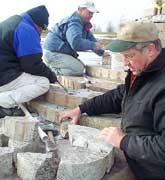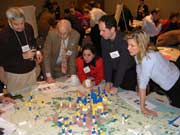 |
|||||||||
|
Volume 13, Issue 6 ~ February 10 - February 16, 2005
|
|||||||||
|
|
Ted Neuman keeps our stormwater — but lightning keeps its own counsel Lightning strikes, ice-overs, surging waters and invading plants are all part of Ted Neuman’s job. That job is stormwater management, and Neuman’s three-year-old Tymatt Industries thrives on the simple law that water flows downhill. Balancing physics, engineering and the laws of nature, Neuman slows the flow of millions of gallons of water from rushing into the Bay after every rainstorm, helping to preserve water quality in Bay waters and tributaries. “It’s pretty interesting to see what nature can do,” Neuman said, shuffling out on an ice-covered stormwater pond one early February afternoon. Because sometimes nature won’t be held back. Last year, a bolt of lightning targeted one of his ponds, grounding itself through an 18-foot fountain mounted in honor of science. The fountain once circulated water in the 4.7-acre Maryland Technology Center stormwater pond, known as Lake Fibonacci, at routes 50 and 301. A series of granite disks stacked with the widest at the bottom, narrowing to smaller disks at the top, the fountain is inscribed with mathematical formulas in tribute to Fibonacci, the 13th century author of Liber abaci, a book introducing new mathematical concepts after the dark ages. Scientist-designer Helamon Ferguson based the profile of his fountain on a formula involving the golden ratio, an irrational number, and Fibonacci’s sequence of numbers. Even the 14 streams of water shooting from the fountain are located on the x-axis in line with Fibonacci’s numbers. The lightning bolt’s fury shattered the formula, knocking off the top disks and blasting chunks of granite from the base. “The lightning was like a bomb,” Neuman said. Now it’s time to repair the strike. Braced for the chilly air in thick black canvas jacket and khaki workman’s pants, Neuman, 57, arranged a lightning-fractured disk as if deciphering a puzzle. “It’s putting Humpty-Dumpty back together,” Neuman said as he picked up softball-sized chunks of granite.
Usually, Neuman’s challenges from nature come at more foreseen paces rather than as random events. As with the laws of nature, Neuman’s also driven to respect laws of the land. Federal law says that water cannot leave a developed area of land at a faster rate than it would if the land had remained undeveloped. Neuman’s solution is to build a large holding pond that will release water into the storm drains at this natural rate To ensure that water keeps its slow, natural pace, modern landscapes are dotted with huge ponds spanning acres to hold excess water that runs off lawns, roads, parking lots and other properties. A weir, or outlet pipe set in a cement and wire box, controls the amount of water released into the storm drains. “These ponds can handle water for even 100-year storms, the worst storm in 100 years,” Neuman said.  His company looks after more than 60 such ponds in the Washington, D.C., metro area. Charges in his care include the ponds at Annapolis Harbour Center and Waugh Chapel and throughout the Washington Metro system. His company looks after more than 60 such ponds in the Washington, D.C., metro area. Charges in his care include the ponds at Annapolis Harbour Center and Waugh Chapel and throughout the Washington Metro system. You’ve seen such stormwater ponds everywhere, he says, with more than a thousand in Anne Arundel County alone, including those owned by homeowners associations. Stormwater can even be controlled underground when space is limited, by an underground grit-separator, a tank that can be the size of a large parking lot. Other systems include a series of ponds that water flows through to settle out silt. “We’re really managing an ecosystem,” said Neuman of his work. Often this means balancing the wants and needs of developers and homeowners with the laws of nature and water quality. This means teamwork, especially when it comes to algae control. “We work with the landscapers on how much fertilizer is running into the ponds and try to make sure they don’t load it up with nutrients,” he said. Neuman also works with developers in helping them to meet the federal laws. “We try to talk to the developers early,” Neuman said. “There’s a lot you can do as you’re designing a system.” After construction, each pond has its own maintenance needs: occasional silt-dredging, herbicide applications or vegetative barriers such as long grass. Not only must Neuman look after these mini-reservoirs, but he looks after what’s in the pond — goldfish, fountains, water lilies and other plants. “If it deals with stormwater, we take care of it,” Neuman said of his Lothian-based company. This is the first lightning encounter Neuman’s had to repair, but he’s had plenty of other challenges, including battles with algae, weeds, cattails and snakes. One Canada goose can release up to a ton of nutrients into the water every year, he says with the certainty of one who’s cleaned up after geese. Such challenges leave him wondering. “What are we doing to the ecosystem?” Neuman worries. “The more you develop, the more you impact the water system.” For instance, when you re-channel water, he explained, it increases the velocity with bank-eroding energy. Such are the ecosystem challenges Neuman hopes to solve through his stormwater-slowing systems. The rewards of his job, however, far outweigh the challenges. Neuman, a Montana native and former conservation district supervisor, has been solving stormwater problems for 50 years. “It’s a labor of love for me,” Neuman explained, traces of his Northwest accent surfacing. “This is something I really like to do.” He’s used to playing by the rules, balancing the most extreme forces of nature with the area’s citizens. Neuman knows well the ecosystems rules that we must live by. “You can’t,” he said, “fool Mother Nature.” —Carrie Steele
Match-making for people and pets Connie Hirschman got her Valentine a little early this year. Skipper, a terrier-mix foundling, had been Hirschman’s companion for six years. “We thought he was young when we got him, but really he was older,” Hirschman, a real estate agent, remembered. A heart murmur and other health problems eventually claimed his life. “You don’t ever replace a pet, you just have fond memories. A friend says there’s always room for one more,” said Hirschman. “And there was this big hole.” Thus began her search for a new companion. In the days before Christmas, she read that Calvert Humane Society planned a pajama party to match animals with good homes. [“There’s No Place Like Home,” Vol. XII, No 51: Dec. 16]. “I didn’t plan to go, but somehow I found myself down there,” said Hirschman, who lives in Deale. “The volunteers were so fabulous. I didn’t have many requirements, but the dog had to be small. It had to get along with my five cats. And I didn’t want to walk through kennels where every dog would cry out to me.” As Hirschman waited in the lobby of the society’s Fishing Creek Kennel in Sunderland, a volunteer made the match. “They put this little ball of red fur in my lap,” says Hirschman. Her year-old mix-breed suited her to a T. “I absolutely fell in love with this little dog,” Hirschman said. “Scamp — formerly Champ — was definitely hand-picked for me.” Following the required home-study, where volunteers made sure her house was ready for adopting an animal, Hirschman welcomed home her energetic new love. “All five of my cats and my previous dogs have been adopted,” Hirschman said. “The fact that they need a home as much as I need a friend makes it work for everybody.” During the same weekend, the Humane Society found homes for a dozen dogs and cats — plus guinea pigs. There’s still more than enough puppy and kitty love in local shelters to fill your heart this Valentine’s Day. Find your animal companion at —
—Carrie Steele
Tackling population growth stacking LEGOs By the time millennial babies are having families of their own, two million more people will surround the U.S. Capitol, sprawling all the way from the Blue Ridge to Chesapeake Bay. It’s going to get pretty crowded. Where will all these people live? Work? Park? Drive? Planners who’ll be retired by 2030 are already at their wits’ ends as they try to make room for the multitudes to come. The challenge is so daunting that it sent some 300 of them reverting back to childhood last week. There they were, a room full of elected officials and community, environmental, housing and business leaders, all playing with yellow, blue and white LEGO building blocks. “It just raises your awareness so much,” said Barbara Samorajczyk, Anne Arundel County Councilwoman, reflecting on the mounds of plastic LEGOs she was scouting places for. “That is a lot of growth to put into an area.” Games were first on the agenda at the Reality Check summit on regional growth, held on Groundhog’s Day in Washington, D.C. But the message of the Urban Land Institute’ Washington District Council and the Washington Smart Growth Alliance was serious. Encircling 30 tables, the 300 players agreed on their rules of the game: protecting green spaces, balancing jobs and houses, developing near major transit lines and within existing town centers. Then they began to play. It was LEGO blocks, not LEGO’s signature yellow-headed people, that were traded and shuffled around six-by-eight-foot map grids. Each group arranged 543 LEGOs, color-coordinated for various housing densities (yellow) and jobs (blue). What resulted was stacks of LEGOs, lots of discussion and lots more questions. “We need to envision what legacy we want to leave for our children,” said Samorajczyk, who helped place LEGOs on the Reality Check map. “We have to use every tool available if we are making decisions based on values,” she said. Will Baker, president of the Chesapeake Bay Foundation, felt the pressure building, too. “There’s no question about the greater stress and challenge that this kind of growth will have on the Bay,” he said. Samorajczyk and Baker joined players from Maryland, Virginia and Washington, D.C., representing more than 20 jurisdictions, including Anne Arundel and Calvert counties. Gerritt Knapp, the director of the National Center for Smart Growth Research and Education at the University of Maryland, summed up LEGO-findings in front of a packed room of more than 400 people with standing room only. “Clearly, the group thought there should be more houses and jobs near transit stations,” Knapp said of the checkered LEGO map results. That two states and the District of Columbia could come together to plan for 25 years ahead impressed many. “It was a great opportunity for people in the region to meet with each other,” said Jenny Plummer-Welker of Calvert County planning, who attended and met planners she hopes to work with in the future. One of the next steps, players agreed, was gathering ideas from area citizens for a long-term growth strategy. This strategy had worked for another metropolitan area project, Envision Utah, around Salt Lake City. When people feel like their opinion matters, Summit organizers said, they’re more likely to see things from a broader view, rather than just their own neighborhood. So stay tuned: the summit was just the beginning. “We consider this the kick-off,” said David Flanagan of the Smart Growth Alliance. “We need your vision and effort to continue on, so we’ll all have a better place to live.” —Carrie Steele
Companion Gardening On the Eastern Shore, word is that the fast-ferry plan that would hook up Virginia’s Somerset County isn’t moving very fast. Consultants can’t find an operator wanting to take the gamble without subsidies. And the Times-Dispatch writes that Alabama businessman Edward Von Bergen, whose company was knocked out of the ferry business in Alabama by a hurricane, no longer is interested … |
||||||||





 lant Professor
lant Professor